DECKERS CREEK, West Virginia |
||
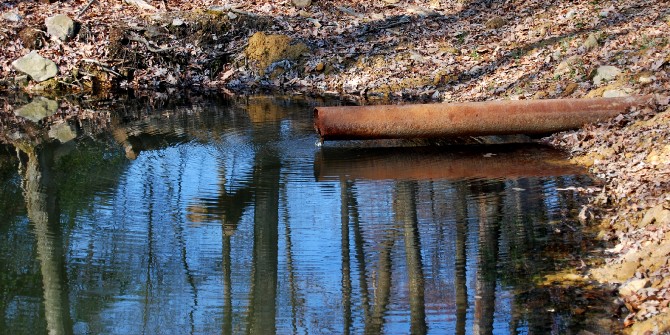 |
||
Source pond at spring. |
||
————————————————————————————————— This essay was originally posted to National Geographic's Water Currents blog on December 1, 2016. ————————————————————————————————— Special thanks to Holly Purpura, FODC (Friends of Deckers Creek) Director, and Erika Osborne. —————————————————————————————————
As a tributary of the Monongahela River, which runs through north-central West Virginia, I am only 24.6 miles (39.6 km) in length, with a watershed of 64-square miles. In my upper reaches I flow through some beautiful stretches of land, including a rocky gorge that is particularly stunning in autumn. My beginnings are quite humble. I trickle out from a small spring on private land where my pH level is a strong 7.7. This is a good number and indicates drinking water quality. In chemistry, pH is a measure of the acidity of a solution: The lower the number, the more acidic the liquid. About six miles from my mouth, at the lower reach of the watershed, my waters turn a deep terra cotta red-orange and the pH level drops all the way down to 4.2 due to acid mine drainage leaking into my system. It looks like I am bleeding from an ugly open wound. For many years this highly toxic concoction has been gurgling out of the old Richard’s Coal Mine, along with discharges of aluminum, iron and manganese. |
||
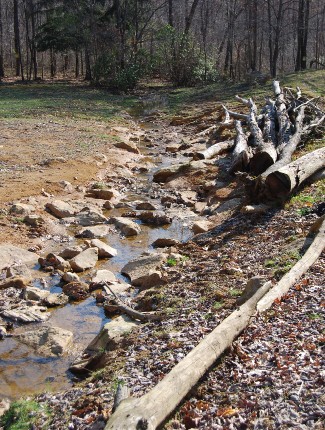 |
 |
|||
Beginnings of the creek. |
Water samples showing pH levels. |
|||
The Richard Mine was opened in 1903 by the West Virginia Coal Company. By 1942, the mine employed over five hundred people and produced more than 600,000 tons of coal. During the extraction process, pyrite (a composition of iron and sulfur) reacts to surface water and oxygen to form sulfuric acid and dissolved iron, creating a highly acidic solution that can dissolve metals such as iron, aluminum, and manganese found in the bedrock. When the contaminated water encounters a higher alkalinity environment, the solution precipitates its metals, especially iron-hydroxide, that bright red-orange drainage found flowing into my body. |
||
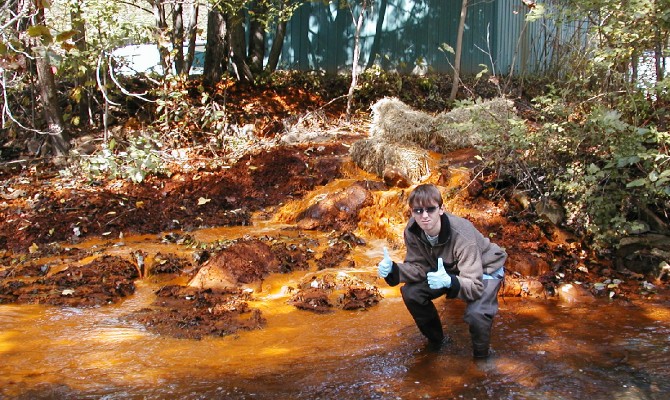 |
||
An optimistic volunteer for FODC (Derek Springston) at the Richard Mine discharge site. Photographer unknown |
||
Because the Upper Freeport coal seam is still found today throughout the region, this abandoned mine unfortunately continues to produce acid drainage. The water seeps into the mineshaft and when the pool rises above the level of my surface flow, it spills out. Due to the close proximity to my mouth, the dilution of the Richard Mine toxicity is greater than near my headwaters.
Today the hillsides still bleed blood-orange in areas from acid mine drainage. This byproduct is the long-term cost of coal production in the region. Because coal was not sustainably mined, communities will be paying for it with high cost remediation for years to come, as well as with negative impacts to property values and ecological health.
But it’s not all bad news. As with so many of my other relatives around the world, caring people are stepping up to take care of us. Here in West Virginia, Friends of Deckers Creek (FODC) is a community-based group composed of hydrologists, water remediation specialists, local citizens, kayakers and bikers working together on my behalf to improve water quality and end decades of environmental abuse inflicted on my watershed. They have begun to find ways to reduce the toxic flow coming into my body and have crews working to clean up the trash that is so carelessly dumped into me.
Through remediation projects, education, and community outreach it is the FODC’s goal to make me a fishable and swimmable creek again, envisioning my waters as an asset instead of a liability. In my upper watershed, eight drainage treatment sites, operated by Friends of Deckers Creek have been constructed to greatly reduce the toxins emptying into my system. There have been delays in getting a treatment facility installed at the Richard Mine due to the high costs and a lack of funding from the West Virginia and federal government. Hopefully, these obstacles can be overcome. |
||
 |
||
Drainage treatment pond. Photo by Holly Purpura, FODC Director |
||
Also, during the past six years, the FODC has partnered with the West Virginia Department of Natural Resources, and Trout Unlimited, to stock young brown trout fingerlings in my watershed. There have been occurrences of individuals catching 14-inch brown trout while fly-fishing, but usually the fish are around 8-10 inches long.
It is possible to follow my entire course on bicycle along a trail converted from old railroad tracks. Bikers, hikers, joggers and parents pushing baby strollers all enjoy this path. Upstream of the outflow is a scenic section where I cascade over waterfalls, boulders, and rockslides to create world class kayaking. |
||
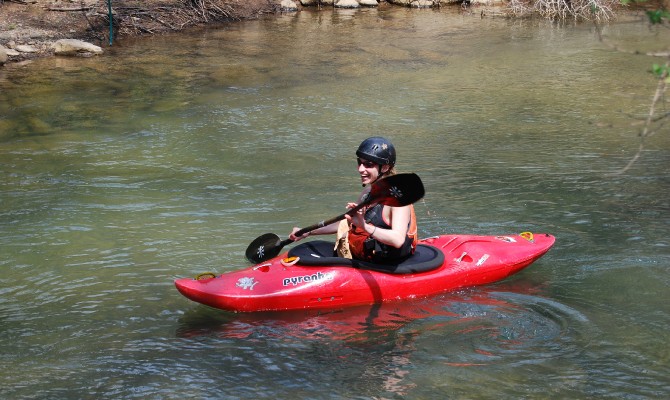 |
||
Enjoying the upper reaches in a kayak. |
||
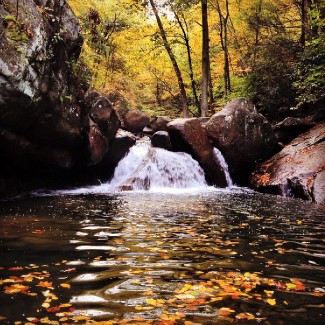 |
 |
|||
Deckers Creek gorge in autumn. Photo by Nick Revetta, FODC Project Manager |
Caddis fly larvae. |
|||
A tiny friend who lives under rocks close to shore in my healthy reaches is the caddis fly larvae, of the order Trichoptera. They do well in the waters upstream from where the mine drainage occurs, and are amazing underwater architects. They build dwellings from whatever minute substrate material is nearby as a protective coat for their fragile bodies during the time they are in the larval stage, before they grow into flies. The cases, constructed from small pieces of sand, twig or aquatic plants, are held together with silk excreted from salivary glands near their mouths. Caddis fly cases are open at both ends with the soft bodies protruding from the larger end, allowing them to move while dragging their cases with them. As an indicator species, these larvae witness my health daily. |
||
next page: Great Miami River >
< previous page: French Broad River




































